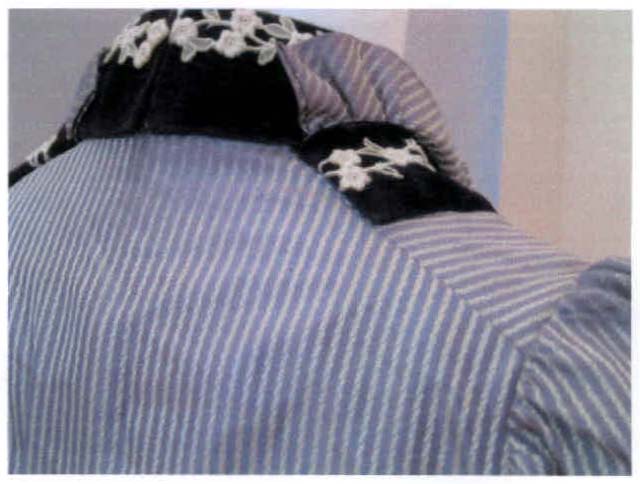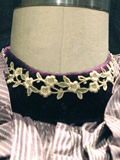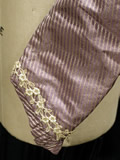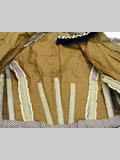The Department of Dramatic Art at the University of North Carolina at Chapel Hill houses a historical collection of over 1,000 garments dating back to 1840, in an archive called Costar. Through careful examination of the garments, we are meticulously cataloging every piece of clothing for future historical research. As a research assistant, I helped photograph, analyze, and record a portion of the extensive collection for display at http://drama.unc.edu/costar. As a graduate student I also had a personal project which involved a two-step process. First was pinpointing a bodice's date and then reproducing the garment using contemporary means. I dated the bodice by analyzing the actual structure of the bodice itself while concurrently comparing it to a range of historical research, namely periodicals, academic texts and other surviving garments from the period. Then I reproduced the garment by developing a pattern, altering it to fit the modem body, and then duplicating the historical dressmaking techniques and materials.
To determine the date of this bodice, I viewed the archives of Vogue magazine on microfilm, examining the changing styles throughout a two-year period between May 1899 and December 1901. At the turn of the century, fabrics and colors followed seasons: light fabrics and colors in the summer, moving to darker colors and heavier fabrics in the winter. These factors as well as visual clues from the magazine's illustrations, led me to conclude that this long sleeved bodice, made from violet and white striped silk taffeta fabric with velvet trim, would have been introduced in the late summer/early fall of 1900. The research showed that the sleeve heads were gradually deflating leading up to the turn of the century. And, the bodice fullness is slim at the sides but full at the breast. Following is a detailed description of this bodice from the University of North Carolina's Costar collection.
Foundation
Almost all bodices from this time were made on a fitted and boned foundation. This particular bodice closes with eleven size two hooks and eyes placed along the center front on a soft cotton foundation. It also has fifteen bones hand sewn to the seams and darts which create the shape of the garment (see Figure 1). The foundation of the lining is constructed by two methods. In some parts the foundation has been seamed or darted before the fashion fabric has been gathered to it. In other parts, the fashion fabric and foundation have been flat-lined and treated as one. The center back has four panels that are flat lined to the one gathered panel of the fashion fabric. The same goes for the front where there is a deep dart in the lining. These panels are then flat lined with rest of the bodice foundation to the fashion fabric. The seam allowances are finished with a 1/2" strip of cotton binding the edges, and then the bones are hand stitched over the seams. An interesting note on the bones is that there is one bone on each side of center front that is sewn between the lining and bodice. It is hand sewn to the lining to the inside and then encased between the two fabrics. There are also two small panels on the lining that are of a slightly different fabric than the rest of the lining which raises the question if the bodice had been altered after it's initial construction (see Figure 2). Finally, the sleeves are also flat-lined with cotton fabric. The armholes are trimmed down to 1/4" and finished with a hand overcast in a contrasting color.
 |
 |
| Figure 1 | Figure 2 |
Front
 On initial glance, the bodice has the pouched front indicative of the early 1900s. On closer inspection, it is actually the precursor to this fashion. The back and sides are still fitted to the body with the beginning traces of a pouched-front primarily at the neck. The column "Vogue's Weekly Pattern" from January 18, 1900 on page 48 illustrates these details (reproduced at the end of this essay on the right side and labeled Exhibit A). On this garment, the center front is pleated and hand tacked at the waist with 1/4" tucks that have 1 1/2" returns, as seen in the illustration on the left. All this fullness gathers into the neckline at the top producing a full front. Dressmakers were masters of disguising openings, and this bodice is no different. The center front is folded back on the selvedge on both sides and left to loosely fall into itself - no hooks and eyes keep it closed. It is a natural closing. The stripes run down the center front and then radiate over the bust into a smooth side and shoulder seam, meaning that all the fullness is concentrated on the front. The neckline is finished off by a 1/4" bias binding. Close to the side seam is a dart that makes the underarm section lay smooth against the body. As noted by Nora Waugh on page 231 in The Cut of Women's Clothes 1600-1930 "As fine materials look poor when seamed, the fullness was reduced by pin tucks or gathering."
On initial glance, the bodice has the pouched front indicative of the early 1900s. On closer inspection, it is actually the precursor to this fashion. The back and sides are still fitted to the body with the beginning traces of a pouched-front primarily at the neck. The column "Vogue's Weekly Pattern" from January 18, 1900 on page 48 illustrates these details (reproduced at the end of this essay on the right side and labeled Exhibit A). On this garment, the center front is pleated and hand tacked at the waist with 1/4" tucks that have 1 1/2" returns, as seen in the illustration on the left. All this fullness gathers into the neckline at the top producing a full front. Dressmakers were masters of disguising openings, and this bodice is no different. The center front is folded back on the selvedge on both sides and left to loosely fall into itself - no hooks and eyes keep it closed. It is a natural closing. The stripes run down the center front and then radiate over the bust into a smooth side and shoulder seam, meaning that all the fullness is concentrated on the front. The neckline is finished off by a 1/4" bias binding. Close to the side seam is a dart that makes the underarm section lay smooth against the body. As noted by Nora Waugh on page 231 in The Cut of Women's Clothes 1600-1930 "As fine materials look poor when seamed, the fullness was reduced by pin tucks or gathering."
Back
 The back of the bodice also has very controlled fullness, although unlike the front, the fullness does not blouse, rather provides a fuller back across the shoulder blades. There are 1/4" tucks that go into the center back waist seam that are also hand tacked 2" above the waist for control, as the illustration on the right shows. Towards the side seam are two narrow panels that help shape the side back. It is not clear why the bodice needed these two panels on each side since they are so small and the area is flat enough that it does not need a curved seam.
The back of the bodice also has very controlled fullness, although unlike the front, the fullness does not blouse, rather provides a fuller back across the shoulder blades. There are 1/4" tucks that go into the center back waist seam that are also hand tacked 2" above the waist for control, as the illustration on the right shows. Towards the side seam are two narrow panels that help shape the side back. It is not clear why the bodice needed these two panels on each side since they are so small and the area is flat enough that it does not need a curved seam.
In all, there are 5 panels across the center back, with the center panel on a fold, stripes going vertically down center back. At the shoulder seam, which slants toward the back from the neck, the stripes match up from front to back. This is probably not an accident seeing how much attention is given to the quality and detail of the garment. The waist is finished all around with a 1" bias facing. The facing is pieced together in many places, which probably means the dressmaker had run out of fabric. On the outside of the bodice is a 3/4" bias strip of velvet applied to the edge. It just hangs slightly over the silk edge of the finished waist. The bias strip is turned under on both edges meeting on the inside and loosely stitched with a 1/2" cross-stitch. The bias is then attached to the hem with a running stitch.
Sleeves
 The sleeves of the bodice are one of the specific characteristics that help determine the date. While bodice silhouettes were remaining pouched in conjunction with the S-shaped corset, the sleeve was evolving much quicker throughout the seasons, as several issues of Vogue at that time suggest. In 1899 the sleeve was very fitted to the arm with a small gather at the shoulder. In the next 5 years, the sleeve begins to balloon back up to a looser and fuller look. This sleeve's fullness is controlled by a small gather from front muscle point to back muscle point with 2 1/4" of ease over the cap. Cut as a two-piece sleeve, the underarm panel is fairly small, yet still matches the stripe pattern as a chevron on both seams of the bodice. I believe that this matching chevron is intentional just like the shoulder seam. The sleeve is angled at the elbow which allows the sleeve to be very fitted through the bicep and forearm down to the wrist. The sleeve is finished off at the wrist with a bias facing and bias ruffle sandwiched between the sleeve and facing, as well as flowered lace trim. The ruffle is 3/4" at the longest part of the sleeve and tapers to nothing at the inside of the wrist. The sleeve is slim at the wrist with a 9" opening, dipping lower on the outside top of the hand, as the illustration depicts.
The sleeves of the bodice are one of the specific characteristics that help determine the date. While bodice silhouettes were remaining pouched in conjunction with the S-shaped corset, the sleeve was evolving much quicker throughout the seasons, as several issues of Vogue at that time suggest. In 1899 the sleeve was very fitted to the arm with a small gather at the shoulder. In the next 5 years, the sleeve begins to balloon back up to a looser and fuller look. This sleeve's fullness is controlled by a small gather from front muscle point to back muscle point with 2 1/4" of ease over the cap. Cut as a two-piece sleeve, the underarm panel is fairly small, yet still matches the stripe pattern as a chevron on both seams of the bodice. I believe that this matching chevron is intentional just like the shoulder seam. The sleeve is angled at the elbow which allows the sleeve to be very fitted through the bicep and forearm down to the wrist. The sleeve is finished off at the wrist with a bias facing and bias ruffle sandwiched between the sleeve and facing, as well as flowered lace trim. The ruffle is 3/4" at the longest part of the sleeve and tapers to nothing at the inside of the wrist. The sleeve is slim at the wrist with a 9" opening, dipping lower on the outside top of the hand, as the illustration depicts.
Decoration
The bodice has three elements of decoration. Velvet bands and collar, self fabric ruffling, and an ivory flower lace trim that is couched onto the collar and bands. The same lace is seen on the bottom of the sleeve. Collars were an integral part of fashion at this time, as an article in Vogue, 22 June 1899 on page 221 states: "Stocks and high neck dressings are strong points which are obligatory to observe where smartness is desired." Labeled Exhibit B, an accompanying illustration from Vogue is reproduced in the center at the bottom of this essay. The collar is a stiff purple velvet band measuring 1 3/4" and dipping to 1 1/2" at center front. It is attached on the left side of the neck edge to the center front opening, but is left free around the right side. It is cut in one piece with the center front on straight grain, and is interfaced with stiff canvas. There is a hook at the right shoulder seam which keeps the collar attached to the neckline and with two hooks and eyes at center back to close the collar (see figure 7 below). It is lined on the inside with black cotton and the ivory lace trim adorns the fashion side. This type of closing can be seen on page 309 in Nancy Bradfield's Costume in Detail on a bodice from 1908 which illustrates the lengths that fashion went to hide closings.
The other decoration is an applied detail on the front of the bodice. While it is made to look like a separate bolero (see figure 6 below), the velvet with attached ruffle is actually hand stitched to the bodice and finished off at the under arm seam and shoulder seam although not into the seam as one might do today (see figure 6). Since the bodice is full at the center front and smooth at the seams, the design element hides the transition between the two, tricking the eye to think there is a shorter jacket over the bodice. The trim is a 1 3/4" shaped velvet piece turned under on both edges and lined with a heavily glazed linen. A 2" bias piece folded in half and gathered forms the ruffle that is hand-stitched to the underside of the velvet. Finally the whole piece is applied by hand to the bodice.
 |
 |
| Figure 6 | Figure 7 |
Summary



I believe that my research accurately dates this piece at the turn of the twentieth century. A Wanamaker's advertisement that appeared in the May 22, 1899 issue of Vogue on page 329 shows a very similar bodice and blouse with slim sleeves, bolero on the front and high neck (See illustration on the right side, marked Exhibit C above). This fashion was very popular at the time and this exquisitely made bodice is a great example of it.
The pattern is on the scale of 1/8" = 1" and is taken from the original bodice. Faint blue grid lines appear in the background of the reproduction of the pattern. The reproduction, made from finely striped silk taffeta, was made for a modern size 4 body with a 26" waist measurement.
© Erin Korey Proud, 2007




